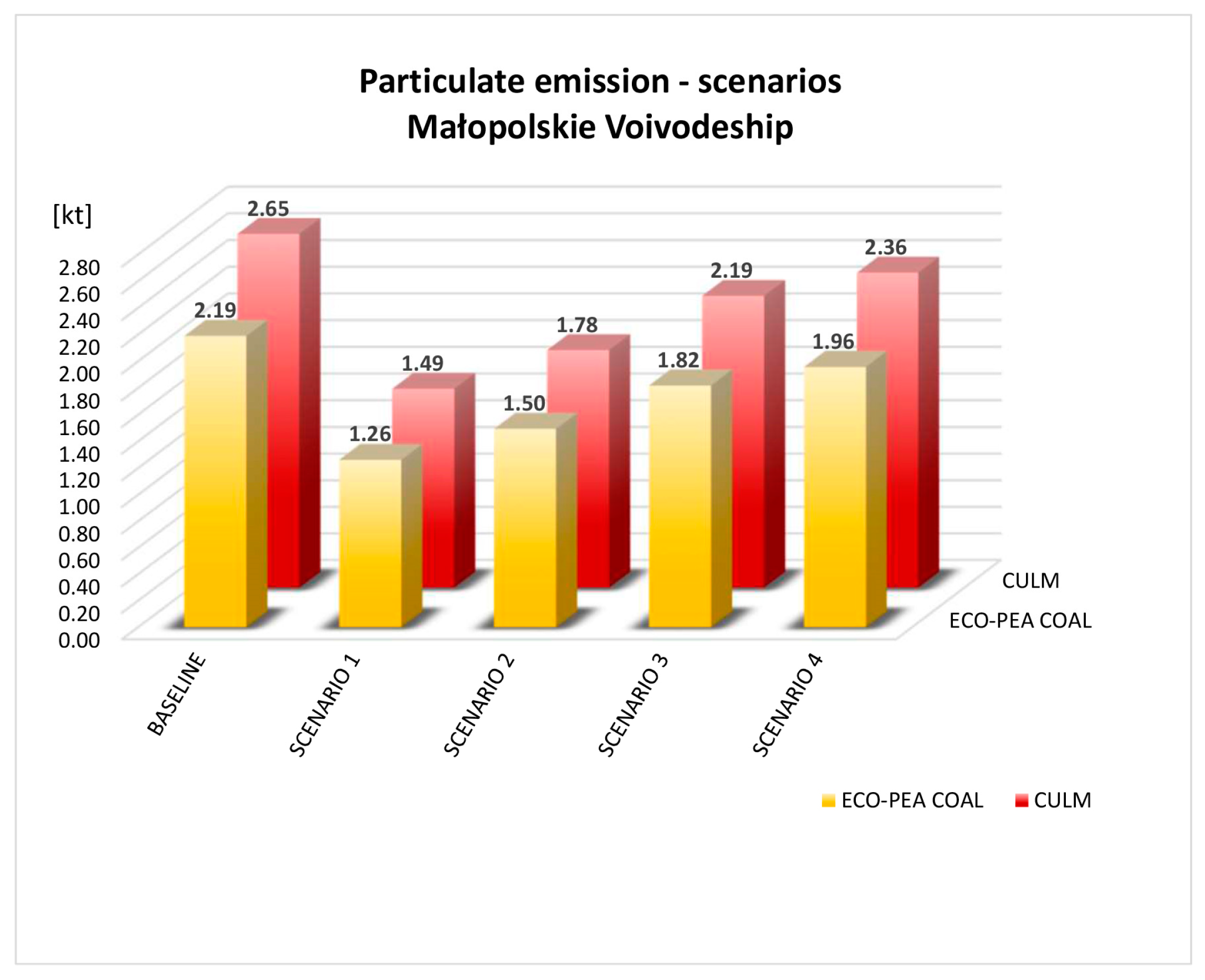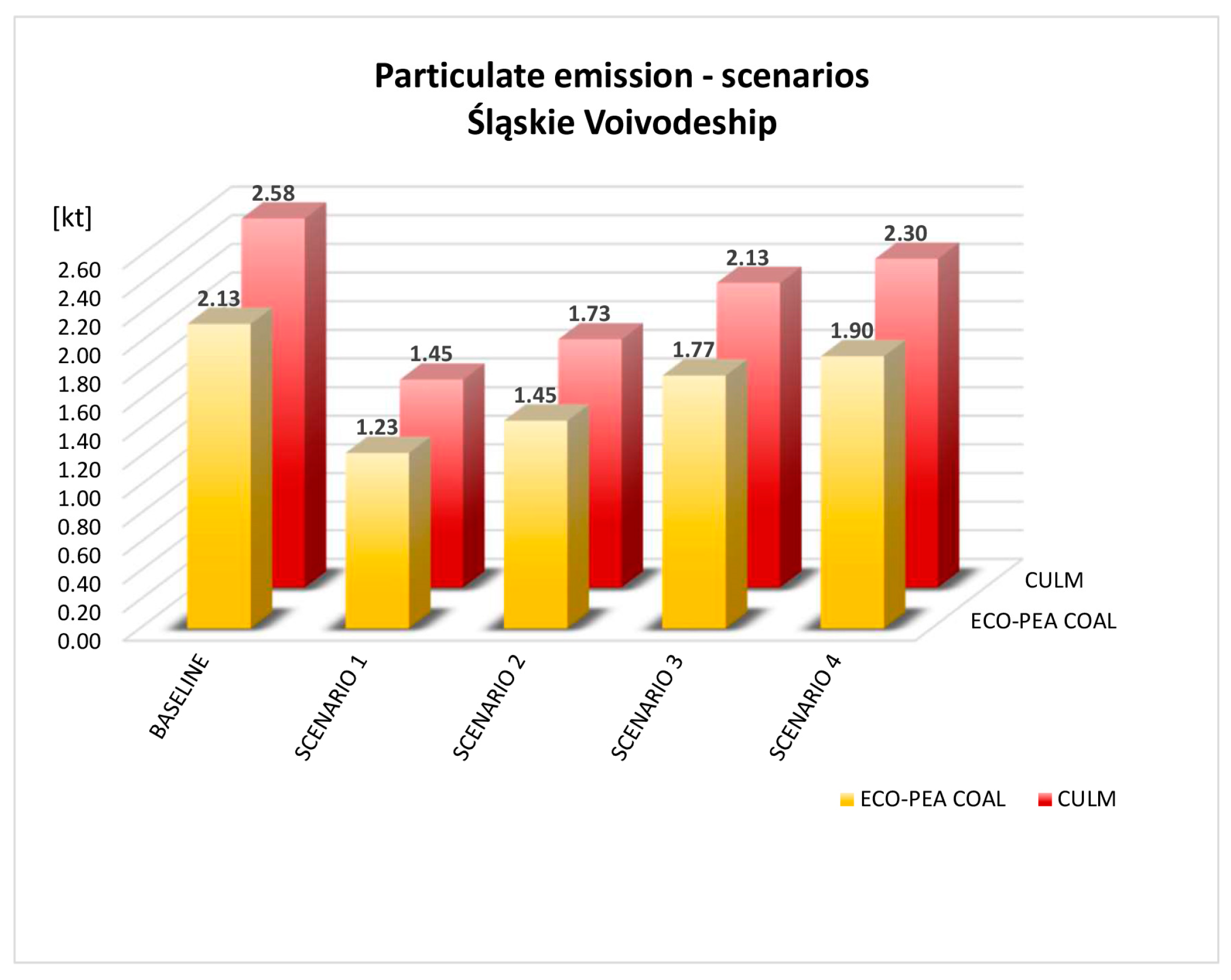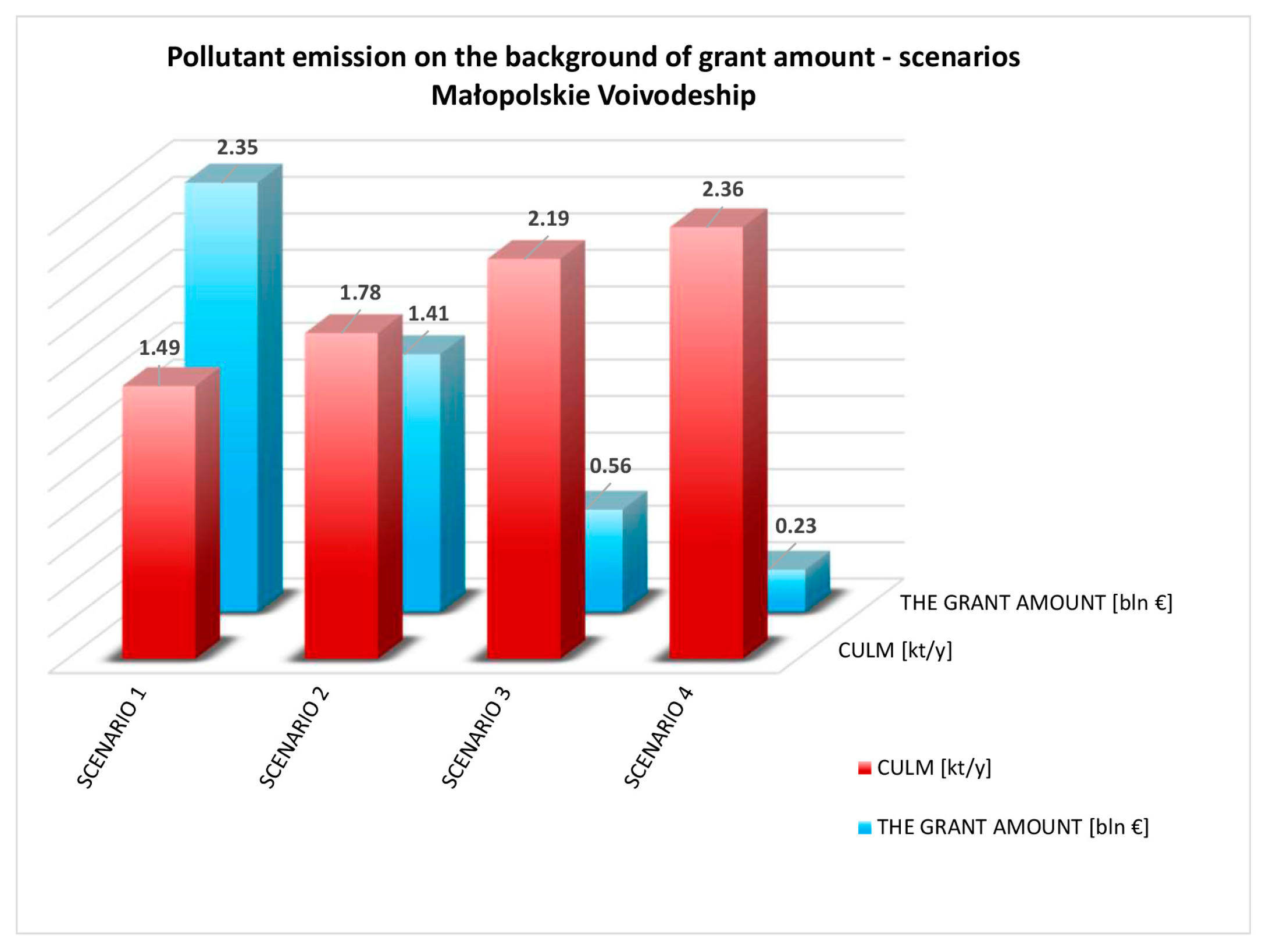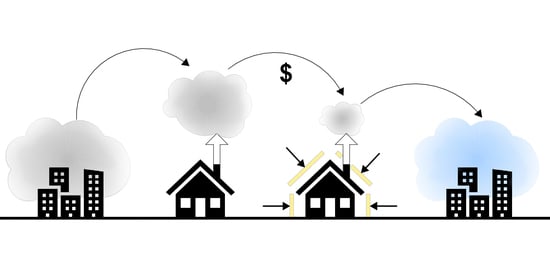Thermal Modernization Cost and the Potential Ecological Effect—Scenario Analysis for Thermal Modernization in Southern Poland
Abstract
1. Introduction
2. Purpose, Methods, and Territorial Scope of the Research
3. Air Pollution—Situation in the Area of Śląskie and Małopolskie Voivodeships
4. Scenario Analysis—Assumptions
- In the first scenario, a 100% subsidy from the state budget was adopted—which is allowed under the “Clean Air” Program. In this scenario, the authors of the article accepted a 100% share of people applying for the building thermal modernization program.
- The second scenario involves 80% state budget funding. In this variant, the involvement of building owners was set at the level of 75% of all respondents.
- In the third scenario, the proposed grant is 60% of the cost, and the number of participants in the thermal modernization program has been set at 40%.
- In the fourth and final scenario, the grant amount was set at 40%. In this case, the projected number of participants in the thermal modernization program decreases to 25% of the total concerned.
- E = emissions of the substance, expressed in kilograms [kg],
- B = fuel consumption: for solid fuels expressed in megagrams/year [Mg/year], in the case of gaseous fuels expressed in millions of cubic metres/year [million.m3/year], liquid fuels expressed in cubic metres/year [m3/year],
- W = the emission factor expressed in kilograms per unit of fuel consumed;
- E′ = emission of the substance after correction due to reduction in the installed device, expressed in kilograms [kg],
- E = emission before the reduction device, expressed in kilograms [kg],
- η = efficiency of the reduction device expressed as a percentage [%];
- E″ = emission of the substance after correction due to the reduction in the installed device, expressed in kilograms [kg],
- η = efficiency of the reduction device expressed as a percentage [%],
- k = content of combustible parts in particulate matter [%],
- E = emission before the reduction device, expressed in kilograms [kg]E = B × W
- E = emission of the substance, expressed in kilograms [kg],
- B = fuel consumption: for solid fuels expressed in megagrams/year [Mg/year], in the case of gaseous fuels expressed in millions of cubic metres/year [million.m3/year], liquid fuels expressed in cubic metres/year [m3/year],
- W = the emission factor expressed in kilograms per unit of fuel consumed.
5. Scenario Analysis of Thermal Modernization in the Małopolskie and Śląskie Voivodeships
5.1. Data Sources
5.2. Financial Costs and Ecological Effects
6. Discussion
7. Conclusions
Author Contributions
Funding
Institutional Review Board Statement
Data Availability Statement
Conflicts of Interest
References
- Blazy, R. Living Environment Quality Determinants, Including PM2.5 and PM10 Dust Pollution in the Context of Spatial Issues—The Case of Radzionków. Buildings 2020, 10, 58. [Google Scholar] [CrossRef]
- European Environment Agency. Poland Country Briefing—The European Environment—State and Outlook 2015. Available online: https://www.eea.europa.eu/soer/2015/countries/poland (accessed on 24 January 2021).
- National Air Protection Program until 2020 (with a Perspective Until 2030). Available online: https://www.gov.pl/web/klimat/krajowy-program-ochrony-powietrza (accessed on 17 February 2021). (In Polish)
- Czyżewski, B.; Trojanek, R.; Dzikuć, M.; Czyżewski, A. Cost-effectiveness of the common agricultural policy and environmental policy in country districts: Spatial spillovers of pollution, bio-uniformity and green schemes in Poland. Sci. Total Environ. 2020, 726, 138–254. [Google Scholar] [CrossRef] [PubMed]
- Woźniak, J.; Pactwa, K. Responsible Mining—The Impact of the Mining Industry in Poland on the Quality of Atmospheric Air. Sustainability 2018, 10, 1184. [Google Scholar] [CrossRef]
- Chief Inspectorate of Environmental Protection: State Environmental Monitoring. Available online: https://www.gios.gov.pl/en/state-of-the-environment/state-environmental-monitoring (accessed on 7 February 2021).
- Tagaris, E.; Sotiropoulou, R.E.P.; Gounaris, N.; Andronopoulos, S.; Vlachogiannis, D. Effect of the Standard Nomenclature for Air Pollution (SNAP) Categories on Air Quality over Europe. Atmosphere 2015, 6, 1119–1128. [Google Scholar] [CrossRef]
- Frankowski, J. Attention: Smog alert! Citizen engagement for clean air and its consequences for fuel poverty in Poland. Energy Build. 2020, 207, 109525. [Google Scholar] [CrossRef]
- Program Czyste Powietrze. Clean Air Program. Available online: https://czystepowietrze.gov.pl/ (accessed on 20 January 2021).
- Dzikuć, M. Problems associated with the low emission limitation in Zielona Góra (Poland): Prospects and challenges. J. Clean. Prod. 2017, 166, 81–87. [Google Scholar] [CrossRef]
- Dzikuć, M.; Piwowar, A.; Dzikuć, M.; Kułyk, P.; £asiñski, K. Economic Conditions of Low Emission Reduction in Poland. DEStech Trans. Comput. Sci. Eng. 2018. [Google Scholar] [CrossRef][Green Version]
- Adamczyk, J.; Piwowar, A.; Dzikuc, M. Air protection programmes in Poland in the context of the low emission. Environ. Sci. Pollut. Res. 2017, 24, 16316–16327. [Google Scholar] [CrossRef]
- Crisis in the Replacement of Coal Stoves—Report of the Polish Smog Alert. Available online: www.polskialarmsmogowy.pl/polski-alarm-smogowy/aktualnosci/szczegoly,kryzys-w-wymianie-weglowych-piecow--raport-polskiego-alarmu-smogowego,1632.html (accessed on 20 January 2021). (In Polish).
- Kocova, D.; Kic, P. Technical and economic aspects of thermal insulation of buildings. Engineering for rural development. In Proceedings of the Conference Proceedings, Jelgava, Latvijas Republika, 25–27 May 2016; pp. 50–55. [Google Scholar]
- Halkos, G.; Tsilika, K. Understanding transboundary air pollution network: Emissions, depositions and spatio-temporal distribution of pollution in European region. Res. Conserv. Rec. 2019, 145, 113–123. [Google Scholar] [CrossRef]
- Staniūnas, M.; Medineckienė, M.; Zavadskas, E.; Kalibatas, D. To modernize or not: Ecological-economical assessment of multi-dwelling houses modernization. Archiv. Civ. Mech. Eng. 2013, 13, 88–98. [Google Scholar] [CrossRef]
- Seibert, R.; Nikolova, I.; Volná, V.; Krejčí, B.; Hladký, D. Air Pollution Sources’ Contribution to PM2,5 Concetration in the Northeastern Part of the Czech Republic. Atmosphere 2020, 11, 522. [Google Scholar] [CrossRef]
- Piotrowska-Woroniak, J.; Woroniak. Redukcja emisji zanieczyszczeń w wyniku termomodernizacyji zabytkowych obiektów sakralnych. Reduction of emission pollution as a result of thermomodernisation historic sacral buildings. Civ. Environ. Eng. 2014, 5, 73–77. (In Polish) [Google Scholar]
- Oleniacz, R.; Kasietczuk, M.; Rzeszutek, M. Ocena efektów termomodernizacji budynków jednorodzinnych. 1. Zmniejszenie zużycia ciepła i emisji zanieczyszczeń do powietrza. Assessment of the effects of thermal renovation of detached houses. 1. Reduction of hest consumption and pollutant emissions into the air. J. Civ. Eng. Environ. Arch. 2014, 61, 183–196. (In Polish) [Google Scholar]
- Lis, A.; Ujma, A. Redukcja emisji pyłów zawieszonych w wyniku poprawy izolacyjności cieplnej przegród i zmiany nośnika energii. Reducing of particulate matter emissions as a result of walls thermal insulation improvement and energy carriers changes. Constr. Optimazed Energy Potential. 2016, 1, 47–54. (In Polish) [Google Scholar]
- Dzikuć, M.; Piwowar, A.; Szufa, S.; Adamczyk, J.; Dzikuć, M. Potential and Scenarios of Variants of Thermo-Modernization of Single-Family Houses: An Example of the Lubuskie Voivodeship. Energies 2021, 14, 191. [Google Scholar] [CrossRef]
- Gambelli, D.; Vairo, D.; Zanoli, R. Exploiting qualitative information for decision support in scenario analysis. J. Decis. Syst. 2012, 19, 407–422. [Google Scholar] [CrossRef]
- Davenport, M.; Delport, M.; Blignaut, N.J.; Hichert, T.; van der Burgh, G. Combining theory and wisdom in pragmatic, scenario-based decision support for sustainable development. J. Environ. Plan. Manag. 2019, 62, 692–716. [Google Scholar] [CrossRef]
- Gaspars-Wieloch, H. Critical Analysis of Classical Scenario-based Decision Rules for Pure Strategy Searching. Organ. Manag. Ser. 2020, 149, 155–165. [Google Scholar]
- Bondos, I.; Lipowski, M. Podejście scenariuszowe w badaniach marketingowych—Zastosowanie i ograniczenia. Scenario Approach in Marketing Research—Applications and Limitations. Mark. Zarz. 2017, 3, 9–17. (In Polish) [Google Scholar]
- Lexa, F.J.; Chan, S. Scenario Analysis and Strategic Planning: Practical Applications for Radiology Practices. JACR 2010, 7, 369–373. [Google Scholar] [CrossRef]
- Lowe, P.; Ward, N. England’s Rural Futures: A Socio-Geographical Approach to Scenarios Analysis. Reg. Stud. 2009, 43, 1319–1332. [Google Scholar] [CrossRef]
- Shalbolt, N.; Apparao, D.; Hunter, S.; Bicknell, K.; Dooley, A. Scenario analysis to determine possible, plausible futures for the New Zealand dairy industry. N. Z. J. Agric. Res. 2017, 60, 349–361. [Google Scholar] [CrossRef]
- Polski Alarm Smogowy. The Polish Smog Alert. Available online: https://www.polskialarmsmogowy.pl/ (accessed on 20 January 2021). (In Polish).
- Chief Inspectorate of Environmental Protection. Assessment of Air Quality in Zones, in Poland in 2019. Available online: https://powietrze.gios.gov.pl/pjp/content/show/1002301 (accessed on 30 January 2021). (In Polish)
- Airly Air Quality Map. Available online: https://airly.org/map/pl/#52.4194125211,18.471849959,z6 (accessed on 31 January 2021).
- Volná, V.; Hladký, D. Detailed Assessment of the Effects of Meteorological Conditions on PM10 Concentrations in the Northeastern Part of the Czech Republic. Atmosphere 2020, 11, 497. [Google Scholar] [CrossRef]
- Krakovská, A.S.; Svozilík, V.; Zinicovscaia, I.; Vergel, K.; Janèík, P. Analysis of Spatial Data from Moss Biomonitoring in Czech–Polish Border. Atmosphere 2020, 11, 1237. [Google Scholar] [CrossRef]
- Podsiadło, K.; Serra, A.O.; Paszyñski, M. Framework for topographic mesh generation and its application to the pollution simulations in Kraków area. Comput. Methods Mater. Sci. 2019, 19, 21–28. [Google Scholar]
- Ścibor, M.; Bokwa, A.; Balcerzak, B. Impact of wind speed and apartment ventilation on indoor concentrations of PM10 and PM2. 5 in Kraków, Poland. Air Q. Atmos. Health 2020, 13, 553–562. [Google Scholar] [CrossRef]
- Raport o Stanie Środowiska w Województwie Małopolskim w 2017 roku Wojewódzki Inspektorat Ochrony Środowiska w Krakowie. Report on the state of the Environment in the Małopolskie Voivodeship in 2017, Voivodeship Inspectorate for Environmental Protection in Krakow. Available online: http://krakow.pios.gov.pl/stan-srodowiska/publikacje/raporty-o-stanie-srodowiska/ (accessed on 23 January 2021). (In Polish)
- Dziubanek, G.; Spychała, A.; Marchwińska-Wyrwał, E.; Rusin, M.; Hajok, I.; Ćwieląg-Drabek, M.; Piekut, A. Long-term exposure to urban air pollution and the relationship with life expectancy in cohort of 3.5 million people in Silesia. Sci. Total Environ. 2017, 580, 1–8. [Google Scholar] [CrossRef]
- Kowalska, M.; Skrzypek, M.; Kowalski, M.; Cyrys, J. Effect of NOx and NO2 Concentration Increase in Ambient Air to Daily Bronchitis and Asthma Exacerbation, Silesian Voivodeship in Poland. Int. J. Environ. Res. Public Health 2020, 17, 754. [Google Scholar] [CrossRef] [PubMed]
- Raport o Stanie Środowiska w Województwie Śląskim w 2017. Wojewódzki Inspektorat Ochrony Środowiska w Katowicach. Report on the State of the Environment in the Śląskie Voivodeship in 2017, Voivodeship Inspectorate for Environmental Protection in Katowice. Available online: http://www.katowice.wios.gov.pl/index.php?tekst=monitoring/raporty/i (accessed on 25 January 2021). (In Polish).
- Kobza, J.; Geremek, M.; Dul, L. Characteristics of air quality and sources affecting high levels of PM10 and PM2.5 in Poland, Upper Silesia urban area. Environ. Monit. Assess. 2018, 190, 515. [Google Scholar] [CrossRef]
- Energy Efficiency in Poland. 2017 Review; Zaborowski, M., Walczak, E., Eds.; Institute of Environmental Economics (IEE): Kraków, Poland, 2018.
- Kaczmarczyk, M.; Sowiżdżał, A.; Tomaszewska, B. Energetic and Environmental Aspects of Individual Heat Generation for Sustainable Development at a Local Scale—A Case Study from Poland. Energies 2020, 13, 454. [Google Scholar] [CrossRef]
- Wojewódzki Fundusz Ochrony Środowiska i Gosodarki Wodnej w Poznaniu. Zestawienie Wzorów i Wskaźników Emisji Substancji Zanieczyszczających Wprowadzanych do Powietrza. Provincial Fund for Environmental Protection and Water Management in Poznañ. Summary of Formulas and Indicators of Emissions of Polluting Substances Discharged into the Air. Available online: www.wfosgw.poznan.pl/wp-content/uploads/2018/01/Definicja-i-wzór-efektu-OA-2018.pdf (accessed on 20 January 2021). (In Polish).
- Minister of Investment and Development of Republic of Poland. Announcement of the Minister of Investment and Development of 8 April 2019 on the Publication of the Uniform Text of the Ordinance of the Minister of Infrastructure on Technical Conditions to Be Met by Buildings and Their Location; The Prime Minister of Republic of Poland: Warsaw, Poland, 2019; Volume 2019. (In Polish)
- Kryzia, D.; Pepłowska, M. The impact of measures aimed at reducing low-stack emission in Poland and on energy efficiency and the household emission of pollutants. Polityka Energetyczna 2019, 22, 121–131. [Google Scholar] [CrossRef]
- Lewandowski, P.; Sałach, K.; Ziółkowska, K. The Assessment of Labour Demand Generated by Single-Family Buildings Modernisation Projects Implemented in the Voivodships of Małopolskie and Śląskie. In Energy Efficiency in Poland. 2017 Review; Zaborowski, M., Walczak, E., Eds.; Institute of Environmental Economics (IEE): Kraków, Poland, 2018; pp. 82–86. [Google Scholar]
- Blazy, R. Planning Problems and the value of the Urban and Natural Landscape Problems in the Silesian Agglomeration. In IOP Conference Series: Materials Science and Engineering; IOP Publishing: Bristol, UK, 2019; Volume 471, p. 112012. [Google Scholar]
- Śleszyński, P.; Gibas, P.; Sudra, P. The Problem of Mismatch between the CORINE Land Cover Data Classification and the Development of Settlement in Poland. Remote Sens. 2020, 12, 2253. [Google Scholar] [CrossRef]
- Ciepiela, A.; Łasocha, M. Urban sprawl and spatial planning documents: The case of the municipality of Biecz, Poland. Przestrz. Forma 2020, 44, 231–248. [Google Scholar]
- Runge, A.; Runge, J. Polityka lokalna i regionalna w świetle depopulacji– na przykładzie województwa śląskiego. Stud. KPZK 2017, 178, 133–160. [Google Scholar]
- Blazy, R.; Hrehorowicz-Gaber, H.; Hrehorowicz-Nowak, A. Green Infrastructure—Countering Ecosystem Fragmentation: Case Study of a Municipality in the Carpathian Foothills. Forests 2021, 12, 78. [Google Scholar]
- Węcławowicz-Bilska, E. Wpływ aktywności gospodarczej na kształt przestrzeni małych miast w Karpatach Polskich. The influence of economic activity on the shape of small towns in Polish Carpathians mountains. Space Soc. Econ. 2016, 17, 85–99. (In Polish) [Google Scholar] [CrossRef][Green Version]
- Blazy, R.; Błachut, J.; Ziobro, A. Wpływ Drogowych Korytarzy Transportowych na Przekształcenia Małych i Średnich Miast w Polsce Południowej. The Impact of road Transport Corridors on the Transformation of Small and Medium-Sized Cities in Southern Poland; Węcławowicz- Bilska, E., Ed.; Wydaw. PK: Cracow, Poland, 2019. (In Polish) [Google Scholar]
- Ciepiela, A.; Kania, O.; Łabuz, R. Małe Miasta o Układach Historycznych w Polsce Południowej. Small Cities and Towns with Historical Urban Layouts in Southern Poland; Wdowiarz-Bilska, M., Ed.; Wydaw. PK: Kraków, Poland, 2019. (In Polish) [Google Scholar]
- CSO 2011. National Population and Housing Census 2011 (Narodowy Spis Powszechny Ludności i Mieszkań 2011). Central Statistical Office (CSO). Available online: https://stat.gov.pl (accessed on 12 January 2021).
- Pytliński, Ł. Technical condition of single-family buildings in Poland. Renovation needs, heat sources and energy performance standards. In Energy Efficiency in Poland. 2017 Review; Zaborowski, M., Walczak, E., Eds.; Institute of Environmental Economics (IEE): Kraków, Poland, 2018; pp. 28–68. [Google Scholar]
- Ośrodek Wdrożeń Ekonomiczno-Organizacyjnych Budownictwa PROMOCJA Sp. z o.o. Center for Economic and Organizational Implementation of Construction PROMOTION Ltd. Sekocenbud. Available online: https://www.sekocenbud.pl/aktualnosci/publikacje-ekspertow/sekocenbud-wlasciwy-dla-rynkowej-wyceny-kontraktow-i-opinii-sadowych/ (accessed on 25 January 2021).
- Zarządzenie Prezesa Komitetu do Spraw Urbanistyki i Architektury z Dnia 28 Sierpnia 1957 r. w Sprawie Normatywu Urbanistycznego dla Niskiego Budownictwa Mieszkaniowego. M.P. 1957 nr 74 poz. 453. Available online: http://isap.sejm.gov.pl/isap.nsf/DocDetails.xsp?id=WMP19570740453&SessionID=05A5CF885238D6C5191AC7E60F6ABAD02FE6DEE4 (accessed on 19 March 2021).
- Bac-Bronowicz, J.; Grzempowski, P. Regionalization of geographical space according to selected topographic factors in reference to spatial distribution of precipitation: Application of artificial neural networks in GIS. Environ. Earth Sci. 2018, 77, 1–17. [Google Scholar] [CrossRef]
- Bergel, T.; Kotowski, T.; Woyciechowska, O. Daily water consumption for household purposes and its variability in a rural household. J. Ecol. Eng. 2016, 17, 47–52. [Google Scholar] [CrossRef]
- Masłoń, A. Dynamika zmian jednostkowej dobowej ilości ścieków w jednorodzinnym gospodarstwie domowym. Rynek Instal. 2015, 10, 69–73. (In Polish) [Google Scholar]
- Program Ochrony Powietrza dla Województwa Małopolskiego. Air Protection Programme for Małopolskie Vivodeship. Uchwała Nr XXV/373/20 Sejmiku Województwa Małopolskiego z dnia 28 września 2020 r. w sprawie Programu ochrony powietrza dla województwa małoposkiego. Available online: http://edziennik.malopolska.uw.gov.pl/legalact/2020/6337/ (accessed on 19 March 2021). (In Polish)
- Analitis, A.; De’ Donato, F.; Scortichini, M.; Lanki, T.; Basagana, X.; Ballester, F.; Astrom, C.; Paldy, A.; Pascal, M.; Gasparrini, A.; et al. Synergistic Effects of Ambient Temperature and Air Pollution on Health in Europe: Results from the PHASE Project. Int. J. Environ. Res. Public Health 2018, 15, 1856. [Google Scholar] [CrossRef] [PubMed]





| Voivodeship | Małopolskie | Śląskie |
|---|---|---|
| Number of non-insulated buildings | 190,500 | 293,200 |
| Number of insulated buildings | 373,200 | 254,000 |
| Number of buildings using solid fuel stoves (insulated and non-insulated) | 435,000 | 470,000 |
| Number of single-family buildings | 563,700 | 547,200 |
| Type of Renovation Investments | Renovation Needs—Preferences |
|---|---|
| Modernization of the heating system, including boiler replacement | 34.1% |
| Roof renovation with insulation | 26.5% |
| Insulation of building walls | 26.0% |
| Voivodeship | Number of Single-Family Buildings | Number of Potential Buildings Subject to Thermal Modernization |
|---|---|---|
| Małopolskie | 563,700 | 146,562 |
| Śląskie | 547,200 | 142,272 |
| In total | 1,110,900 | 288,834 |
| Scenario and % of Support | Co-Financing Amount for Thermal Modernization (EUR) | Number of Buildings Covered by the Program | Potential Cost of Modernization of Buildings in Millions of Euros |
|---|---|---|---|
| First 100% | 16,000 | 146,562 | 2344.9 |
| Second 80% | 12,800 | 109,921 | 1406.9 |
| Third 60% | 9600 | 58,625 | 562.8 |
| Fourth 40% | 6400 | 36,640 | 234.5 |
| Scenario and% of Support | Co-Financing Amount for Thermal Modernization (EUR) | Number of Buildings Covered by the Program | Potential Cost of Modernization of Buildings in Millions of Euros |
|---|---|---|---|
| First 100% | 16,000 | 142,272 | 2276.3 |
| Second 80% | 12,800 | 106,704 | 1365.8 |
| Third 60% | 9600 | 56,909 | 546.3 |
| Fourth 40% | 6400 | 35,568 | 227.6 |
| Solid Fuel (Coal) | CO2 (kg/Year) | CO (kg/Year) | Particulate Matter (kg/Year) | SO2 (kg/Year) | NOx (kg/Year) |
|---|---|---|---|---|---|
| Boiler for culm | 17,529 | 721.8 | 18.11 | 98.99 | 14.44 |
| Boiler for eco-pea coal | 14,469 | 595.8 | 15.95 | 81.71 | 11.92 |
| Solid Fuel (Coal) | CO2 (kg/Year) | CO (kg/Year) | Particulate Matter (kg/Year) | SO2 (kg/Year) | NOx (kg/Year) |
|---|---|---|---|---|---|
| Boiler for culm | 9878 | 406.80 | 10.20 | 55.79 | 8.14 |
| Boiler for eco-pea coal | 8349 | 343.80 | 8.62 | 47.15 | 6.88 |
| Scenario | Number of Buildings | Subsidy (in Millions Euro) | Solid Fuel Boiler | Reduction of Emissions | ||||
|---|---|---|---|---|---|---|---|---|
| CO2/kT Per Year | CO/kT Per Year | Particulate Matter/kT Per Year | SO2/kT Per Year | NOx/kT Per Year | ||||
| 1 | 146,562 | 2344.9 | Culm | 1121.3 | 46.2 | 1.16 | 6.4 | 1.0 |
| Eco-pea coal | 897.0 | 37.0 | 0.93 | 5.0 | 0.7 | |||
| 2 | 109,921 | 1406.9 | Culm | 841.0 | 34.7 | 0.87 | 4.8 | 0.7 |
| Eco-pea coal | 672.7 | 27.8 | 0.70 | 3.9 | 0.6 | |||
| 3 | 58,625 | 562.8 | Culm | 448.5 | 18.5 | 0.46 | 2.6 | 0.35 |
| Eco-pea coal | 358.7 | 14.8 | 0.37 | 2.2 | 0.29 | |||
| 4 | 36,640 | 234.5 | Culm | 280.3 | 11.5 | 0.29 | 1.6 | 0.24 |
| Eco-pea coal | 224.2 | 9.3 | 0.23 | 1.3 | 0.23 | |||
| Scenario | Number of Buildings | Subsidy (in Millions Euro) | Solid Fuel Boiler | Reduction of Emissions | ||||
|---|---|---|---|---|---|---|---|---|
| CO2/kT Per Year | CO/kT Per Year | Particulate Matter/kT Per Year | SO2/kT Per Year | NOx/kT Per Year | ||||
| 1 | 142,272 | 2276.3 | Culm | 1088.3 | 44.9 | 1.13 | 6.2 | 1.0 |
| Eco-pea coal | 870.7 | 35.9 | 0.90 | 4.9 | 0.8 | |||
| 2 | 106,704 | 1365.8 | Culm | 816.4 | 33.6 | 0.84 | 4.7 | 0.6 |
| Eco-pea coal | 653.0 | 28.9 | 0.68 | 3.7 | 0.6 | |||
| 3 | 56,909 | 546.3 | Culm | 435.3 | 17.9 | 0.45 | 2.4 | 0.32 |
| Eco-pea coal | 348.3 | 14.3 | 0.36 | 1.9 | 0.27 | |||
| 4 | 35,568 | 227.6 | Culm | 272.1 | 11.1 | 0.28 | 1.6 | 0.21 |
| Eco-pea coal | 217.7 | 8.9 | 0.23 | 1.3 | 0.22 | |||
Publisher’s Note: MDPI stays neutral with regard to jurisdictional claims in published maps and institutional affiliations. |
© 2021 by the authors. Licensee MDPI, Basel, Switzerland. This article is an open access article distributed under the terms and conditions of the Creative Commons Attribution (CC BY) license (https://creativecommons.org/licenses/by/4.0/).
Share and Cite
Blazy, R.; Błachut, J.; Ciepiela, A.; Łabuz, R.; Papież, R. Thermal Modernization Cost and the Potential Ecological Effect—Scenario Analysis for Thermal Modernization in Southern Poland. Energies 2021, 14, 2033. https://doi.org/10.3390/en14082033
Blazy R, Błachut J, Ciepiela A, Łabuz R, Papież R. Thermal Modernization Cost and the Potential Ecological Effect—Scenario Analysis for Thermal Modernization in Southern Poland. Energies. 2021; 14(8):2033. https://doi.org/10.3390/en14082033
Chicago/Turabian StyleBlazy, Rafał, Jakub Błachut, Agnieszka Ciepiela, Rita Łabuz, and Renata Papież. 2021. "Thermal Modernization Cost and the Potential Ecological Effect—Scenario Analysis for Thermal Modernization in Southern Poland" Energies 14, no. 8: 2033. https://doi.org/10.3390/en14082033
APA StyleBlazy, R., Błachut, J., Ciepiela, A., Łabuz, R., & Papież, R. (2021). Thermal Modernization Cost and the Potential Ecological Effect—Scenario Analysis for Thermal Modernization in Southern Poland. Energies, 14(8), 2033. https://doi.org/10.3390/en14082033







